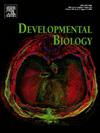Disruption of spindle orientation and protein localization during asymmetric cleavage by pharmacological inhibition of serotonin signaling
IF 2.1
3区 生物学
Q2 DEVELOPMENTAL BIOLOGY
引用次数: 0
Abstract
Cell polarity directs the orientation and size of asymmetric cell division and the segregation of cell fate determinants, processes fundamental to development in all multicellular organisms. During asymmetric cleavage, the mitotic spindle aligns with a specified polarity of the mother cell, and cell fate determinants are distributed asymmetrically along the division axis. Here, we report that pharmacological inhibition of serotonin signaling during the 4-to-8-cell division in early embryos of the mud snail Ilyanassa obsoleta (currently known as Tritia obsoleta) disrupts the typical unequal division pattern. The oblique axis of division common to spirally cleaving molluscan embryos is altered, and the position of the mitotic spindle is randomized in these treatments. Mother cells generate abnormally large, atypically positioned daughter cells. We also find that, in normal embryos, proteins recognized by phosphorylated PKC and Bazooka/PAR-3 antibodies typically co-localize with the spindle apparatus to the apical cortex of each mother cell. These antigens subsequently segregate to the smaller of the two daughter cells. In embryos treated with the serotonin-receptor antagonist, the localization of these asymmetrically segregating proteins is randomized, and their localization is independent of spindle position. These results suggest that serotonin signaling coordinates spindle orientation, cortical polarity, and cell size in early asymmetric cleavages.

药物抑制血清素信号传导对不对称切割过程中纺锤体取向和蛋白质定位的影响。
细胞极性指导不对称细胞分裂的方向和大小,以及细胞命运决定因素的分离,这是所有多细胞生物发育的基本过程。在不对称分裂过程中,有丝分裂纺锤体与母细胞的特定极性对齐,细胞命运决定因素沿分裂轴不对称分布。在这里,我们报道了在泥蜗牛Ilyanassa obsoleta(目前称为Tritia obsoleta)早期胚胎的4到8个细胞分裂过程中,5 -羟色胺信号的药物抑制破坏了典型的不平等分裂模式。在这些处理中,有丝分裂纺锤体的位置是随机的。母细胞产生异常大的、非典型位置的子细胞。我们还发现,在正常胚胎中,磷酸化PKC和Bazooka/PAR-3抗体识别的蛋白质通常与纺锤体共定位到每个母细胞的顶端皮层。这些抗原随后分离到两个子细胞中较小的那个。在用血清素受体拮抗剂处理的胚胎中,这些不对称分离蛋白的定位是随机的,它们的定位与纺锤体位置无关。这些结果表明,血清素信号在早期不对称分裂中协调纺锤体方向、皮质极性和细胞大小。
本文章由计算机程序翻译,如有差异,请以英文原文为准。
求助全文
约1分钟内获得全文
求助全文
来源期刊

Developmental biology
生物-发育生物学
CiteScore
5.30
自引率
3.70%
发文量
182
审稿时长
1.5 months
期刊介绍:
Developmental Biology (DB) publishes original research on mechanisms of development, differentiation, and growth in animals and plants at the molecular, cellular, genetic and evolutionary levels. Areas of particular emphasis include transcriptional control mechanisms, embryonic patterning, cell-cell interactions, growth factors and signal transduction, and regulatory hierarchies in developing plants and animals.
 求助内容:
求助内容: 应助结果提醒方式:
应助结果提醒方式:


